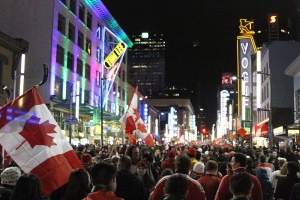Comments on the NWEP’s forum on the future of Sustainable Transportation, held at Douglas College on November 9th, 2010. – Part 2
In the second part of his presentation, Jerry talked on how this one-time event can be used as a model for what transportation will be like in Vancouver in 2050, if the transportation plans of the City are realized. Much of this talk is actually available on the City Vancouver Website, so I won’t go into details here.
Short version: mode shift was responsible for getting most people to most events. Unlike recent Olympics in North America (e.g. Salt Lake City and Atlanta), Vancouver did not send a message for its Citizens to avoid downtown at all costs. Quite the opposite, they set up free events and pavilions around Downtown to encourage people to attend. They just told people to not bother trying to drive in Vancouver.
The City planned for a slight increase in overall traffic for the two weeks, and to avoid traffic gridlock, they hoped for 75% “alternative modes” (transit, bike, walking, rolling office chairs, crowd-surfing, and being dragged down the street on downhill skis being pulled by your drunken buddies I saw all of these on Granville. It was a good party). In the end, they got almost 80%. Notably, their initial estimates of total trips was way too low as there was a 44% increase in trips, but due to the high diversion rate, traffic chaos did not ensue.
Transit chaos only occasionally ensued. But TransLink did a great job managing it, and Jerry was quick to point out how pivotal their role was in running a successful games. I remember spending a half an hour in line at Main Street Station to catch a train home after a Hockey Game. But the line was well managed, organized, and moved pretty swiftly given the circumstances. Only at Jerry’s talk did I realize the people who were out on the street in yellow jackets organizing these lines were TransLink staffers: the managers, planners, secretaries, lawyers, engineers, and custodians who usually occupy TransLink offices were out on the streets during the Olympics, helping make things run smoothly.
Then there was the Olympic Line Streetcar, which proved it worth, moving more than half a million riders during the Olympics and Paralympics. Oh, to have streetcars on our streets again…
There is an inherent problem in all science: either you control all your variables and have an unrealistic model, or you collect real data from the messy real world, and then try to figure out what the variables are after the fact. This is definitely an example of the second half of this problem. It could be argued that the Olympics are a really terrible model for everyday life in the City. Many of the “trips” during the Olympics were taken by tourists, who were unlikely to use a car (as the City’s rental pool was way over depleted). Most of the trips were not people going to work, school, and everyday chores, but were people going downtown to enjoy the festivities: it is safe to assume they would tolerate more inconvenience on the way to the Closing Ceremonies than they would on a daily basis commuting to work. Sobriety is also a confounding factor in every day life that was no significant on February 28, 2010.
So the transportation plan worked, it proved that good planning and an integrated infrastructure not based on single-occupant vehicles can efficiently move larger numbers of people through Vancouver without increasing road capacity. But realistically, this is not the future of Vancouver transportation:
I dunno PJ, i read that VANOC hired so many buses the size of translinks fleet, and some of those companies have yet to be paid, people sure didn’t walk to Whistler !
I also dunno about your inherent problems with all science. I think it’s been said before but science is discovering something, engineering is repeating what science has taught us. Hope that helps !
Yep, VANOC had a bus fleet the size of Translink’s. So if we want to match the success, Translink is going to have to increase capacity to double it’s current fleet.
You might misconstrue my meaning, I have no problem with the science itself, only in how engineers try to apply it. In the end, I was reassured by Jerry’s talk: Vancouver’s liveability will continue to increase through good transportation planning, and those of us in the suburbe (even the “urban suburbs” like Burnaby and New West) will only benefit. The amount of benefit we receive will depend on our local planners…